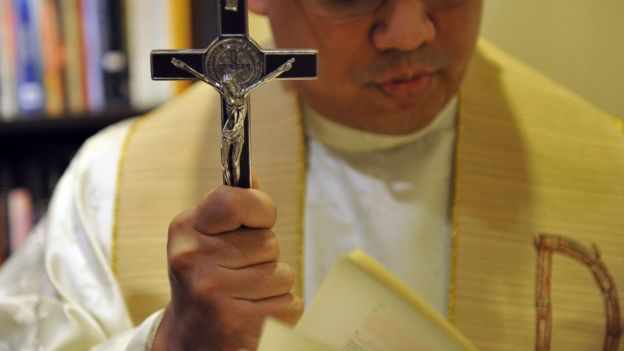Exorcism: Vatican course opens doors to 250 priests
 Image copyright AFP
Image copyright AFP
The Vatican has opened its doors for its annual exorcism course amid increasing demand among some of the world's Catholic communities.
As many as 250 priests from 50 countries have arrived in Rome to learn how to identify demonic possession, to hear personal accounts from other priests and to find out more about the rituals behind expelling demons.Exorcism remains controversial, in part due to its depiction in popular culture and horror films. But there have also been some cases of abuse linked to exorcisms in a range of religious sects.
The week-long Vatican course is described as the only international series of lectures of its kind. Entitled Exorcism and the Prayer of Liberation, it first opened its doors in 2005 and the number of priests attending has more than doubled since then. The event costs €300 (£260, $370) and covers the theological, psychological and anthropological background to exorcisms.
 Image copyright AFP
Image copyright AFP Why is demand growing?
Catholic priests in several countries have told the press there has been an increase in the numbers of people reporting signs of demonic possession.Last year Pope Francis told priests that they "must not hesitate" to refer parishioners to exorcists if they suffer from "genuine spiritual disturbances".
Half a million people reportedly seek exorcisms every year in Italy, while a report by Christian think-tank Theos in 2017 said that the practice was also on the rise in the UK, in part due to the spread of Pentecostal churches.
Some dioceses have developed their own courses to meet the growing demand, including in Sicily and the US city of Chicago.
Father Gary Thomas, an American priest who has practised exorcisms for 12 years, says that one reason for the increase is that as society has begun to rely more heavily on social sciences, fewer churches have trained exorcists. The decline of Christianity has also led to an increase in superstitious practices, he believes.
Italian priest Benigno Palilla told Vatican News that the growing use of tarot cards and sorcery had also led to a renewed demand for exorcisms.
However, very few cases actually require a major exorcism. Out of 180 cases he has seen, Father Thomas says he has carried out just a dozen major exorcisms.
In the Catholic Church, a "major exorcism" can only be carried out by a priest with a bishop's approval.
It involves specific prayers and an invocation for the demon to leave the body of the possessed in Jesus' name.
When do priests perform exorcisms?
 Image copyright Getty Images
Image copyright Getty Images As a result, Father Thomas works with a team of doctors, psychologists and psychiatrists - all practising Catholics - to rule out any other cause for a person's suffering before diagnosing demonic possession.
The priest will then try a series of deliverance prayers. A major exorcism will only take place "as a last resort", he adds.
What happens in an exorcism?
As outlined by www.catholic.org, the priest must wear a type of embroidered white tunic called a surplice alongside a purple stole. The person who is possessed may be bound, and holy water should be used. The priest will make the sign of the cross on the person at several times throughout.The priest calls on saints, prays and reads excerpts from the Bible in which Jesus drives out demons from people.
In Jesus' name, he asks the possessing demon to "yield to God" and "depart", as many times as necessary. Once the priest is convinced the exorcism has worked, he prays to God to prevent the evil spirit from bothering the afflicted person further, and for the "goodness and peace of our Lord Jesus Christ" to take hold of the person instead.
What are the objections?
But there is widespread criticism of exorcism and concern that it has been used by a variety of religious practitioners to carry out abuse of children and other vulnerable people.Some victims have died in rituals linked to exorcism.
More generally, there is a risk that people with illnesses such as epilepsy or schizophrenia could be misdiagnosed and miss out on medical treatment if their symptoms are ascribed to supernatural phenomena.
In 2012, the UK government published a national action plan to help prevent abuse of children in religious rituals.
No comments:
Post a Comment